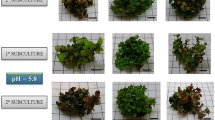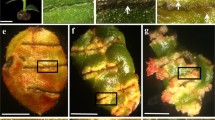Abstract
Proliferating shoot cultures of black mulberry (Morus nigra), derived from axillary buds of two donor trees designated as Mn1 and Mn2, more than 80 years of age, were established in vitro. Subsequently, shoot-tips were used to induce both axillary and adventitious shoot regeneration following incubation on Murashige and Skoog medium containing 14 different treatments of various concentrations of plant growth regulators, including 6-benzyladenine (BA), thidiazuron (TDZ), and combinations of BA with indole-3-butyric acid (IBA) and TDZ with BA. The highest shoot proliferation of 5.3 shoots per explant for the Mn1 tree and 6.9 shoots per explant for the Mn2 tree were obtained when explants were incubated on a medium containing 0.5 mg l−1 BA and 0.1 mg l−1 IBA. The maximum frequency of adventitious rooting was similar for both genotypes. Changes in lignin and cellulose content, macromolecular properties of dioxane and Klason lignins, lignin monomer composition, and macromolecular properties of cellulose were determined in 1-year-old and 3 year-old micropropagated plants, as well as in the donor trees. Lignin and cellulose properties were significantly dependent on the genotype, the age and the mutual interaction of both these factors. The syringyl to guaiacyl weight ratio in lignin rose with the age of the micropropagated plants. Moreover, the tensile strength of wood in 1-year-old plants was supported by a high cellulose degree of polymerization. The highest polydispersity index of cellulose was detected in 3-year-old plants.





Similar content being viewed by others
Abbreviations
- ANOVA:
-
Analysis of variance
- ASTM:
-
American Society for Testing and Materials
- BA:
-
6-Benzyladenine
- DP w :
-
Degree of polymerization
- G:
-
Guaiacyl
- GPC:
-
Gel permeation chromatography
- H:
-
p-Hydroxyphenyl
- HPLC:
-
High-performance liquid chromatography
- IBA:
-
Indole-3-butyric acid
- MS:
-
Murashige and Skoog
- M w :
-
Molecular weight
- NAA:
-
1-Naphthaleneacetic acid
- NBO:
-
Nitrobenzene oxidation
- PD:
-
Polydispersity
- PPFD:
-
Photosynthetic photon flux density
- S:
-
Syringyl
- TDZ:
-
Thidiazuron
References
Agarwal S, Kanwar K (2007) Comparison of genetic transformation in Morus alba L. via different regeneration systems. Plant Cell Rep 26:177–185
Agarwal S, Kanwar K, Sharma DR (2004) Factors affecting secondary somatic embryogenesis and embryo maturation in Morus alba L. Sci Hortic 102:359–368
Bhau BS, Wakhlu AK (2001) Effect of genotype, explant type and growth regulators on organogenesis in Morus alba. Plant Cell Tissue Organ Cult 66:25–29
Bosela MJ, Michler CH (2008) Media effects on black walnut (Juglans nigra L.) shoot culture growth in vitro: evaluation of multiple nutrient formulations and cytokinin types. In Vitro Cell Dev Biol Plant 44:316–329
Chakraborti SP, Vijayan K, Roy BN, Qadri SMH (1998) In vitro induction of tetraploidy in mulberry (Morus alba L.). Plant Cell Rep 17:799–803
Chen CL (1991) Lignins: occurence in woody tissues, isolation, reactions, and structure. In: Lewin M, Goldstein IS (eds) Wood structure and composition. Marcel Dekker, New York, pp 183–261
Chitra DSV, Padmaja G (2005) Shoot regeneration via direct organogenesis from in vitro derived leaves of mulberry using thidiazuron and 6-benzylaminopurine. Sci Hortic 106:593–602
Corral P, Mallón R, Rodríguez-Oubiña J, Gonzáles ML (2011) Multiple shoot induction and plant regeneration of the endangered species Crepis novoana. Plant Cell Tissue Organ Cult 105:211–217
Dai W, Su Y, Castillo C, Beslot O (2011) Plant regeneration from in vitro leaf tissues of Viburnum dentatum L. Plant Cell Tissue Organ Cult 104:257–262
de Almeida JE, Fonseca TC (2002) The forage potential for some mulberry clones in Brazil. In: Sánchez MD (ed) Mulberry for animal production. FAO, Rome. http://www.fao.org/docrep/005/X9895E/x9895e00.HTM
De Rosso M, Cancian D, Panighel A, Dalla Vedova A, Flamini R (2009) Chemical compounds released from five different woods used to make barrels for aging wines and spirits: volatile compounds and polyphenols. Wood Sci Technol 43:375–385
Deroles SC, Seelye JF, Javellana J, Mullan AC (2010) In vitro propagation of Sandersonia aurantiaca Hook using thidiazuron. Plant Cell Tissue Organ Cult 102:115–119
Ďurkovič J (2008) Micropropagation of mature Cornus mas ‘Macrocarpa’. Trees 22:597–602
Hatfield RD, Grabber J, Ralph J, Brei K (1999) Using the acetyl bromide assay to determine lignin concentrations in herbaceous plants: some cautionary notes. J Agr Food Chem 47:628–632
Hayashi K, Oka S (1995) Formation of multiple bud bodies and plant regeneration in the mulberry, Morus alba. J Seric Sci Jpn 47:117–123
Ivanička J (1987) In vitro micropropagation of mulberry, Morus nigra L. Sci Hortic 32:33–39
Jahan MS, Mun SP (2005) Effect of tree age on the cellulose structure of Nalita wood (Trema orientalis). Wood Sci Technol 39:367–373
Jahan MS, Mun SP (2006) Characteristics of milled wood lignins isolated from different ages of Nalita wood (Trema orientalis). Cell Chem Technol 40:457–467
Jahan MS, Mun SP (2007) Characteristics of dioxane lignins isolated at different ages of Nalita wood (Trema orientalis). J Wood Chem Technol 27:83–98
Jain AK, Dandin SB, Sengupta K (1990) In vitro propagation through axillary bud multiplication in different mulberry genotypes. Plant Cell Rep 8:737–740
Kačík F, Solár R, Baloghová D (1995) Analysis of lignin nitrobenzene oxidation products by high performance liquid chromatography (HPLC). Wood Res 40:13–20
Kačík F, Kačíková D, Jablonský M, Katuščák S (2009) Cellulose degradation in newsprint paper ageing. Polym Degrad Stabil 94:1509–1514
Lee Y, Lee D-E, Lee H-S, Kim S-K, Lee WS, Kim S-H, Kim M-W (2011) Influence of auxins, cytokinins, and nitrogen on production of rutin from callus and adventitious roots of the white mulberry tree (Morus alba L.). Plant Cell Tissue Organ Cult 105:9–13
Ma G, Lü J, Teixeira da Silva JA, Zhang X, Zhao J (2011a) Shoot organogenesis and somatic embryogenesis from leaf and shoot explants of Ochna integerrima (Lour). Plant Cell Tissue Organ Cult 104:157–162
Ma G, Teixeira da Silva JA, Lü J, Zhang X, Zhao J (2011b) Shoot organogenesis and plant regeneration in Metabriggsia ovalifolia. Plant Cell Tissue Organ Cult 105:355–361
Marjamaa K, Lehtonen M, Lundell T, Toikka M, Saranpää P, Fagerstedt KV (2003) Developmental lignification and seasonal variation in β-glucosidase and peroxidase activities in xylem of Scots pine, Norway spruce and silver birch. Tree Physiol 23:977–986
Mišalová A, Ďurkovič J, Mamoňová M, Priwitzer T, Lengyelová A, Hladká D, Lux A (2009) Changes in leaf organisation, photosynthetic performance and wood formation during ex vitro acclimatisation of black mulberry (Morus nigra L.). Plant Biol 11:686–693
Mostafa SE, Karam NS, Shibli RA, Alali FQ (2010) Micropropagation and production of arbutin in oriental strawberry tree (Arbutus andrachne L.). Plant Cell Tissue Organ Cult 103:111–121
Murashige T, Skoog F (1962) A revised medium for rapid growth bioassays with tobacco tissue cultures. Physiol Plant 15:473–497
Nitnaware KM, Naik DG, Nikam TD (2011) Thidiazuron-induced shoot organogenesis and production of hepatoprotective lignan phyllanthin and hypophyllanthin in Phyllanthus amarus. Plant Cell Tissue Organ Cult 104:101–110
Pattnaik SK, Chand PK (1997) Rapid clonal propagation of three mulberries, Morus cathayana Hemsl., M. lhou Koiz. and M. serrata Roxb., through in vitro culture of apical shoot buds and nodal explants from mature trees. Plant Cell Rep 16:503–508
Quinn GP, Keough MJ (2002) Experimental design and data analysis for biologists. Cambridge University Press, Cambridge
Seifert VK (1956) Über ein neues Verfahren zur Schnellbestimmung der Rein-Cellulose. Papier 13:301–306
Sharma KK, Thorpe TA (1990) In vitro propagation of mulberry (Morus alba L.) through nodal segments. Sci Hortic 42:307–320
Solár R, Kačík F, Košíková B, Reinprecht L, Čunderlík I (2000) Study of the overall alterations of hornbeam wood chips (Carpinus betulus L.) with the emphasis on lignin in the pretreatment by whiterot fungus Phanerochaete chrysosporium. Wood Res 45:19–32
Solár R, Kurjatko S, Mamoň M, Košíková B, Neuschlová E, Výbohová E, Hudec J (2007) Selected properties of beech wood degraded by brown-rot fungus Coniophora puteana. Drvna Industrija 58:3–11
Thomas TD (2003) Thidiazuron induced multiple shoot induction and plant regeneration from cotyledonary explants of mulberry. Biol Plant 46:529–533
Thomas TD, Bhatnagar AK, Razdan MK, Bhojwani SS (1999) A reproducible protocol for the production of gynogenic haploids of mulberry, Morus alba L. Euphytica 110:169–173
Thomas TD, Bhatnagar AK, Bhojwani SS (2000) Production of triploid plants of mulberry (Morus alba L) by endosperm culture. Plant Cell Rep 19:395–399
Vijayan K, Saratchandra B, Teixeira da Silva JA (2011) Germplasm conservation in mulberry (Morus spp.). Sci Hortic 128:371–379
Wadenbäck J, Clapham D, Gellerstedt G, von Arnold S (2004) Variation in content and composition of lignin in young wood of Norway spruce. Holzforschung 58:107–115
Wayman M, Chua MGS (1979) Characterization of autohydrolysis aspen (P. tremuloides) lignins. Part 2. Alkaline nitrobenzene oxidation studies of extracted autohydrolysis lignin. Can J Chem 57:2599–2602
Weiland JJ, Guyonnet R (2003) Study of chemical modifications and fungi degradation of thermally modified wood using DRIFT spectroscopy. Holz Roh Werkst 61:216–220
Yadav U, Lal M, Jaiswal VS (1990) Micropropagation of Morus nigra L. from shoot tip and nodal explants of mature trees. Sci Hortic 44:61–67
Zhu L-H, Wu X-Q, Qu H-Y, Ji J, Ye J-R (2010) Micropropagation of Pinus massoniana and mycorrhiza formation in vitro. Plant Cell Tissue Organ Cult 102:121–128
Acknowledgments
This paper is dedicated to the late Dr. Július Vachold who contributed significantly to the conservation of old monumental trees in the Krupina region in central Slovakia. The authors thank Dr. D. Gömöry for statistical advice, Mrs. H. Parobková for her excellent laboratory assistance, and Mrs. E. Ritch-Krč for language revision. This publication is the result of the project implementation: ‘Extension of the Centre of Excellence Adaptive Forest Ecosystems’, ITMS 26220120049, supported by the Research & Development Operational Programme funded by the European Regional Development Fund (50%). In addition, this work was financed by the Slovak Grant Agency VEGA (1/0490/09 and 1/0587/09).
Author information
Authors and Affiliations
Corresponding author
Rights and permissions
About this article
Cite this article
Ďurkovič, J., Kaňuchová, A., Kačík, F. et al. Genotype- and age-dependent patterns of lignin and cellulose in regenerants derived from 80-year-old trees of black mulberry (Morus nigra L.). Plant Cell Tiss Organ Cult 108, 359–370 (2012). https://doi.org/10.1007/s11240-011-0047-z
Received:
Accepted:
Published:
Issue Date:
DOI: https://doi.org/10.1007/s11240-011-0047-z




